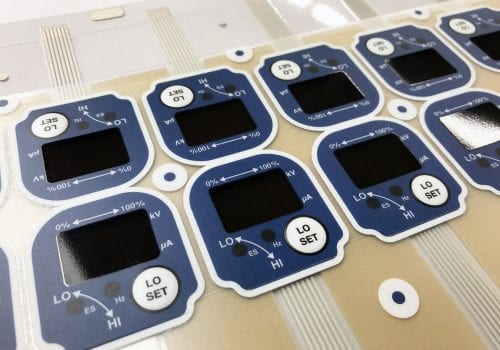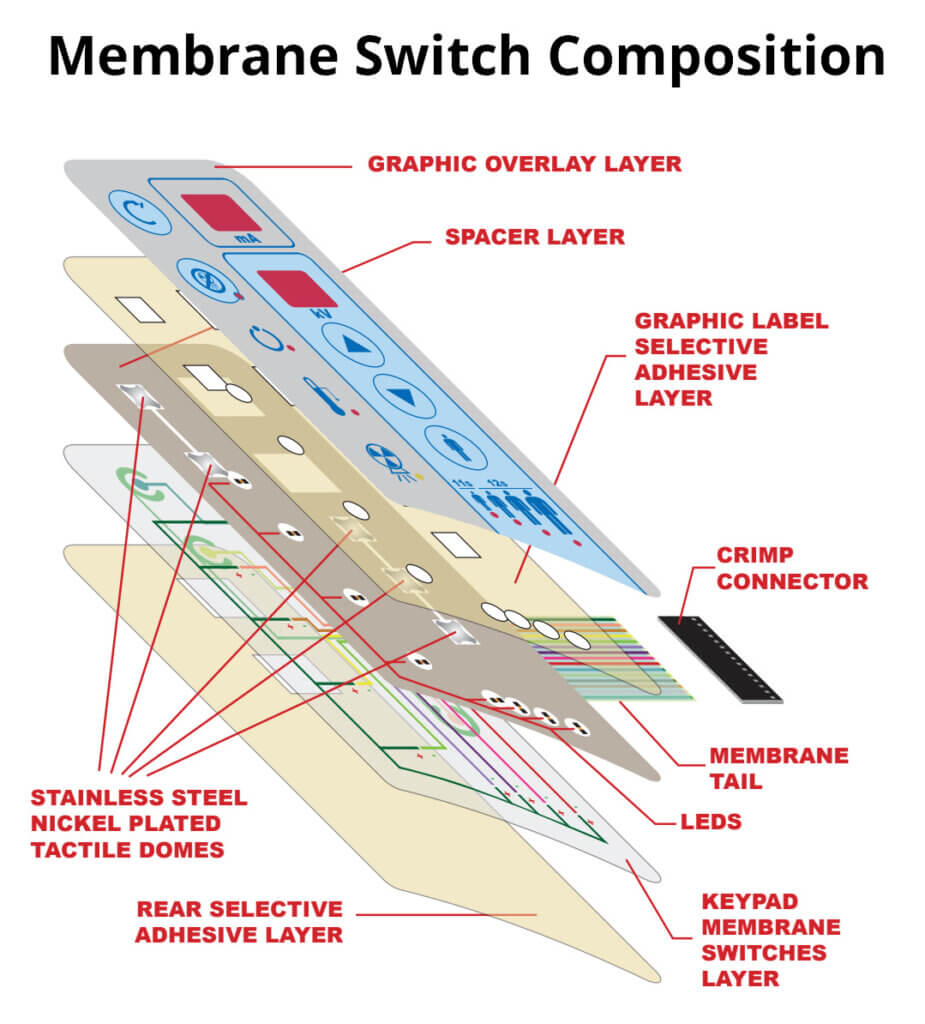Membrane switch durability: What to expect under tough conditions
Everything About Membrane Switch Over: A Comprehensive Overview for Beginners
Membrane buttons are crucial elements in modern-day electronic devices, providing a distinct interface for individual interaction - membrane switch. Their split building, including overlays and conductive traces, supplies performance and sturdiness. Unlike conventional mechanical buttons, membrane layer buttons provide a smooth layout and customizable alternatives. Comprehending their essential features and benefits can change item style. Nevertheless, the details of their application and layout factors to consider necessitate further expedition
What Is a Membrane Switch over?
A membrane button is a kind of electric button that includes an adaptable membrane layer layered over a printed motherboard. This style enables a portable and smooth interface, typically used in various electronic gadgets. Membrane layer switches are typically found in consumer home appliances, clinical devices, and commercial machinery due to their longevity and resistance to environmental factors.The building generally includes multiple layers, such as visuals overlays and adhesive support, which provide tactile comments and secure the wiring below. The procedure of a membrane layer button is launched when stress is applied to the surface, finishing an electric circuit.These switches are valued for their convenience, allowing personalized layouts and printed graphics that accommodate certain interface. Their inconspicuous nature lowers space requirements, making them ideal for applications where typical switches may not fit. Generally, membrane switches offer a practical and aesthetic remedy for modern electronic devices.
Key Components of Membrane Layer Changes
Membrane changes consist of several essential components that add to their performance and performance. The leading layer, recognized as the overlay, supplies the interface and is often printed with signs or graphics. Below the overlay lies a spacer layer, which divides the conductive aspects and avoids unintended activation. The following important part is the graphic layer, which enhances aesthetic appeals and guarantees the toughness of the design.Conductive traces, usually made from materials like silver or carbon, are published on the circuit layer. When pressure is applied to the overlay, these traces enter into contact, finishing the circuit. Additionally, a support layer offers architectural support and can be made from products such as polyester or polycarbonate. Together, these parts produce a trusted, straightforward user interface suitable for numerous applications, from home home appliances to industrial tools. Understanding these components is important for anyone curious about membrane button modern technology.
Exactly How Membrane Layer Switches Work
Recognizing how membrane switches over function is necessary for appreciating their widespread usage in numerous devices. A membrane layer switch operates with a collection of layers, consisting of a graphic overlay, spacer, and a circuit layer. When pressure is related to the overlay, it presses the spacer layer, permitting the circuit layer to make get in touch with and finish an electric circuit. This activity sends a signal to the tool, triggering a feedback, such as activating a light or triggering a function.Membrane changes can be developed with numerous attributes, including tactile comments, backlighting, and customized graphics, improving individual communication. Their building and construction permits a sealed design, safeguarding the interior elements from dust, wetness, and impurities. This durability makes them suitable for diverse applications, from customer electronic devices to commercial tools. On the whole, the simplicity and performance of membrane layer switches over add to their appeal in modern technology.
Advantages of Membrane Switches Mechanical Buttons
While mechanical switches have long been a staple in numerous devices, membrane switches over offer distinct benefits that make them significantly appealing. One substantial advantage is their slim profile, permitting even more small designs and better adaptability in item advancement. Additionally, membrane layer changes function an uniform surface area, which improves visual charm and streamlines cleansing, making them suitable for settings where hygiene is critical.Another advantage is their resistance to dirt and wetness. Unlike mechanical buttons, which can be jeopardized by environmental factors, membrane layer switches offer a sealed user interface that secures against pollutants - membrane switch. Furthermore, membrane layer buttons usually have a longer life-span because of fewer relocating parts, causing boosted sturdiness and reliability.Cost-effectiveness is also a notable advantage, as membrane layer buttons can be produced in mass with lower production expenses. These aspects incorporate to place membrane layer switches as a sensible alternative to standard mechanical options in numerous applications
Typical Applications of Membrane Layer Switches
Membrane buttons are widely made use of in various markets, specifically in consumer electronics and commercial control board. In consumer gadgets, they supply a smooth, easy to use interface, while in commercial setups, they improve longevity and performance. Recognizing these applications highlights the flexibility and usefulness of membrane switches in modern technology.
Consumer Electronics Gadgets
As consumer electronics continue to develop, membrane layer buttons have actually come to be a prominent choice for a variety of gadgets because of their adaptability and sleek layout. These buttons are generally located in smart devices, tablets, and remotes, where room is minimal and visual appeals matter. Their reduced account and personalized layouts permit suppliers to create straightforward user interfaces that boost the total individual experience. Furthermore, membrane layer switches are commonly made use of in appliances such as microwaves and coffee machine, giving instinctive control choices while standing up to wetness and dirt. The sturdiness and dependability of membrane switches make them ideal for day-to-day consumer items, making certain long life and constant performance. On the whole, their combination in customer electronic devices reflects a mix of performance and contemporary design.
Industrial Control Panels
The applications of membrane layer changes extend past customer electronics, locating substantial usage in industrial control board. These switches are favored for their durability and resistance to rough atmospheres, making them perfect for making and procedure control settings. They supply a reputable interface for drivers to manage machinery, screen processes, and change setups. Membrane layer switches can be personalized to suit certain operational needs, including features like backlighting and responsive feedback, boosting individual experience. Their inconspicuous design enables integration right into different tools, while their ability to stand up to spills, dust, and severe temperatures warranties longevity. On the whole, membrane layer switches add to secure and efficient procedure in commercial applications, demonstrating their flexibility and efficiency popular environments.
Factors To Consider for Creating Membrane Layer Switches Over
When developing membrane buttons, their website picking the right products is necessary to ensure longevity and functionality. In addition, recognizing layer configuration methods can considerably influence the this page switch's performance and individual experience. These factors to consider play a vital duty in creating effective and trusted membrane layer switch styles.
Product Choice Significance
Product option plays an essential role in the design and performance of membrane layer buttons. The selected materials directly impact the button's longevity, responsive action, and general aesthetic. Secret factors to consider include the substrate, which should offer structural honesty while permitting adaptability, and the graphic overlay, which requires to be immune to put on and environmental elements. Conductive materials must assure reputable electric efficiency, while adhesives must provide strong bonding without jeopardizing the switch's procedure. Additionally, compatibility with making procedures and end-user environments is vital; materials must hold up against differing temperature levels, moisture degrees, and chemical direct exposure. Ultimately, appropriate material choice not only boosts the membrane button's performance but additionally adds to its longevity and customer fulfillment, making it a critical facet of the style procedure.

Layer Configuration Strategies

Regularly Asked Questions
The Length Of Time Do Membrane Layer Changes Typically Last?
Membrane buttons typically have a life-span of 1 to 5 million cycles, relying on usage and ecological problems. Factors such as style top quality and operating regularity significantly affect their sturdiness and overall performance durability.

Can Membrane Layer Switches Over Be Personalized for Particular Styles?
Membrane switches can certainly be customized to suit details styles, permitting varied shapes, shades, and capabilities. This adaptability allows producers to tailor these buttons to satisfy unique aesthetic and operational needs successfully.
What Materials Are Used in Membrane Layer Change Building?
Membrane layer switches are normally built making use of materials such as polyester, polycarbonate, and glue layers. These materials supply versatility, resistance, and resilience to environmental variables, making sure the buttons function successfully in numerous applications and problems.
Are Membrane Changes Immune or water resistant to Moisture?
Membrane layer switches can be developed to be moisture-resistant, using specialized coatings and products. Their water-proof capacities depend on building and construction top quality and particular applications, making it necessary to analyze needs for excellent efficiency in numerous settings.
How Are Membrane Layer Switches Over Fixed if Damaged?
Repairing damaged membrane layer changes normally entails changing the impacted layer or circuit. Specialists may also use conductive sticky or make use of specialized repair service sets, making sure performance is restored without total substitute of the whole switch assembly. Unlike traditional mechanical buttons, membrane layer buttons present a smooth design and personalized options. A membrane button is a type of electrical button that is composed of a versatile membrane layered over a published circuit board. The operation of a membrane switch is launched when stress is applied to the surface area, completing an electrical circuit.These buttons are valued for their versatility, making it possible for custom-made designs and published graphics that cater to particular user interfaces. While mechanical buttons have long been a staple in several gadgets, membrane layer switches over deal distinct benefits that make them increasingly appealing. Membrane layer switches typically have a longer lifespan due to less moving parts, resulting in boosted toughness and reliability.Cost-effectiveness is additionally a noteworthy advantage, as membrane buttons can be produced in mass with reduced manufacturing expenses.